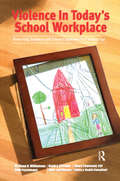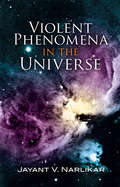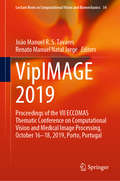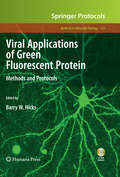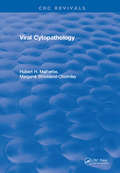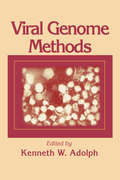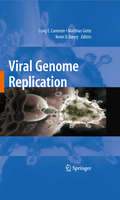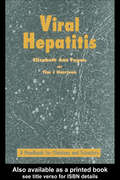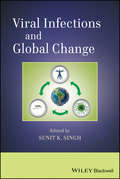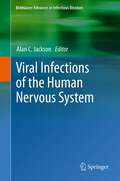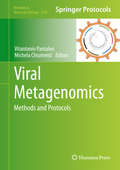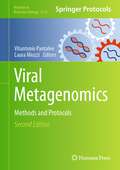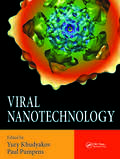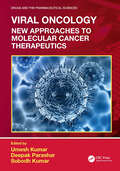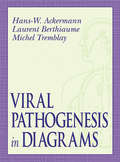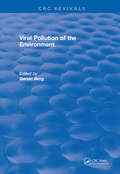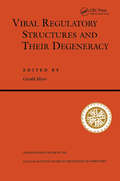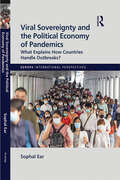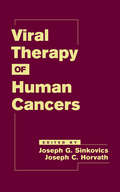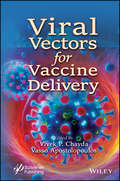- Table View
- List View
Vinyl Acetate Emulsion Polymerization and Copolymerization with Acrylic Monomers
by Yildirim H. ErbilThe versatility of the emulsion copolymerization reaction and the ability to control the properties of the final latices have led to rapid expansion both in the quantity of polyvinylacetate and vinyl acetate-acrylic copolymer latices and in their applications. Vinyl Acetate Emulsion Polymerization and Copolymerization with Acrylic Monomers provides
Violence in Today's School Workplace: Protecting Teachers and School Employees in a Violent Age
by Diane H. Williamson David E. Strecker Henry TownsendIncreasingly, headlines today report out-of-control student violence occurring in our schools and colleges. Yet so little concrete action is being taken to protect the bystanding victims of this trauma, the school worker. Classroom teachers, administrators, coaches, school bus drivers, cafeteria workers, custodians, and other school employees a
Violent Phenomena in the Universe
by Jayant V. NarlikarThe serenity of a clear night sky belies the evidence--gathered by balloons, rockets, satellites, and telescopes--that the universe contains centers of furious activity that pour out vast amounts of energy, some in regular cycles and some in gigantic bursts. This reader-friendly book, acclaimed by Nature as "excellent and uncompromising," traces the development of modern astrophysics and its explanations of these startling celestial fireworks.This lively narrative ranges from the gravitational theories of Newton and Einstein to recent exciting discoveries of such violent phenomena as supernovae, pulsars, X-ray sources, active galaxies, radio sources, and quasars. An in-depth exploration of the Big Bang covers both conventional theory and subsequent issues that cast doubt upon its explanation of the birth of the universe. Several appendixes offer supplements to the text's main topics, and a helpful glossary and tables of references appear at the end.
VipIMAGE 2019: Proceedings of the VII ECCOMAS Thematic Conference on Computational Vision and Medical Image Processing, October 16–18, 2019, Porto, Portugal (Lecture Notes in Computational Vision and Biomechanics #34)
by João Manuel R. S. Tavares Renato Manuel Natal JorgeThis book gathers full papers presented at the VipIMAGE 2019—VII ECCOMAS Thematic Conference on Computational Vision and Medical Image Processing—held on October 16-18, 2019, in Porto, Portugal. It discusses cutting-edge methods, findings, and applications related to 3D vision, bio- and medical imaging, computer-aided diagnosis, image enhancement, image processing and analysis, virtual reality, and also describes in detail advanced image analysis techniques, such as image segmentation and feature selection, as well as statistical and geometrical modeling. The book provides both researchers and professionals with extensive and timely insights into advanced imaging techniques for various application purposes.
Viral Applications of Green Fluorescent Protein
by Barry W. HicksOver the last ten years, Green Fluorescent Proteins, along with the other spectral variants, have emerged from near obscurity to become a powerful and versatile tool in scientific research. In Viral Applications of Green Fluorescent Protein: Methods and Protocols, leading investigators from around the world contribute detailed examples of both the construction and application of fluorescent proteins delivered by viruses in a format crafted to produce rapid, readily reproducible results. Written in the style of the popular and successful Methods in Molecular BiologyTM series, the chapters include brief introductions to the topics, lists of the necessary materials and reagents, step-by-step laboratory protocols, and Notes sections, which highlight tips on troubleshooting and avoiding known pitfalls. Cutting-edge and easy to use, Viral Applications of Green Fluorescent Protein: Methods and Protocols supplies researchers with an ideal guide to the many uses of GFP and a vital starting point for future studies utilizing this highly adaptable protein.
Viral Cytopathology
by MalherbeThis book is for the guidance of those wishing to use stained cultures for virus studies.In this manual, sufficient illustrations are presented that may not be otherwise readily available to the reader and indicate the wide range of cytopathic changes. However, it has been necessary to limit the size of the pictures to a minimum - enough to convince the reader that the technique can be of great practical value for the recognition of many different viruses.
Viral Drug Delivery Systems: Advances in Treatment of Infectious Diseases
by Yashwant Pathak Ranjita ShegokarThe disability-adjusted life year (DALY) is a generic measure of health effect that can be used in cost-effectiveness analysis as an alternative to the quality-adjusted life year (QALY). Infectious diseases are one of the major to cause significant losses of DALY and QALY. Human infectious diseases are disorders that are triggered by the micro-organisms such as bacteria, fungi, viruses, or parasites. The majority of such diseases are contagious and create a public health menace. There are several reasons why infectious diseases are deadly diseases, and one of the primary reasons is the drug resistance developed over time. Drug resistance-associated mutations are linked to increasing drug efflux, modifications of the drugs, or their targets. Every year, new drugs are being approved by FDA to treat infectious diseases. Nonetheless, the infectious diseases will undoubtedly persist as permanent and main threats to humanity for now and in the future, primarily due to increased longevity that almost always comes at a cost of impaired immunity.A total of four books are covered under the series of Infectious drug diseases.- Malarial drug delivery systems- Tubercular drug delivery systems- Viral drug delivery systems- Infectious disease drug delivery systemsThe third volume of series is focused on viral drug delivery systems. Typically, virus attaches to the cells (referred as host cell) and releases its DNA or RNA inside the cell. In second stage, virus’s genetic material takes control of the cell and forces it to replicate the virus leading to onset of disease symptoms. DNA class of viruses include Herpes, Papilloma and Adeno viruses. RNA class of viruses include retroviruses, such as HIV immunodeficiency virus and SARS COV – 2 / Corona virus. This book addresses recent developments in viral drug delivery systems. It covers many different aspects of viral infections, ways to treat them using modern drug delivery systems like nano particulate carriers. The choice of viral delivery systems mainly depends upon the type of virus, duration of life cycle, presence of drug resistance, cellular and mucosal interaction of virus, accordingly gene or non-gene drug delivery systems are selected. Besides that, this book also reports global dynamics of viral diseases, future predictions of infection rate, current treatment options, details of drug carriers like nanoemulsions, polymeric nanoparticles, role of biofunctionalization, and phyto-molecules in treatment of viral infections particularly herpes, Covid-19, Ebola, HIV/AIDS, influenza and viral hepatitis.Audiences from a broad range of groups, from researchers, academicians, and public health bodies to regulatory experts, can benefit from the compiled information to learn more about patient needs and current research advances in the field of viral drug delivery research.
Viral Fitness and Evolution: Population Dynamics and Adaptive Mechanisms (Current Topics in Microbiology and Immunology #439)
by Peter Schuster Esteban Domingo Santiago F. Elena Celia PeralesThis book unifies general concepts of plant and animal virus evolution and covers a broad range of topics related to theoretical and experimental aspects of virus population dynamics and viral fitness. Timely topics such as viral mechanisms to cope with antiviral agents, the adaptability of the virus to new hosts, emergence of new viral phenotypes, and the connections between short- and long-term virus evolution are included. By comparing plant and animal viruses, universal mechanisms responsible for fitness variations, viral emergence and disease mechanisms are explored. Although emphasis is put on specific plant and human viral pathogens, relevant similarities and differences to other viruses are highlighted. Additionally, readers will learn more about the adaptability of coronaviruses, including the recently emerged SARS-CoV-2, the causative agent of the COVID-19 pandemic. The book is aimed at students and scientists interested in basic and applied aspects of plant and animal virus population dynamics and evolution.
Viral Genome Methods
by Kenneth W. AdolphMolecular biology and genetics techniques now dominate viral research in attempts to cure diseases such as AIDS. Viral Genome Methods is a practical guide to the newest molecular techniques, providing step-by-step protocols to be used in the laboratory. Recognized authorities and pioneers in viral research pass on their expertise to you.
Viral Genome Replication
by Kevin D. Raney Craig E. Cameron Matthias GotteViruses are responsible for a variety of human, animal, and plant diseases and now represent potential agents of terror. Academic, government, and corporate laboratories have devoted years of effort to the development of strategies to prevent or treat viral infections. Central to the multiplication strategy of all viruses is the process of genome replication. Enzymes critical to this step of the lifecycle have proven to be tractable targets for the development of antiviral agents. Furthermore, genome replication is essential for virus spread and is the main target for the development of antiviral agents. By combining studies of both RNA and DNA viruses - and more - into a single volume, the editors have created a mechanism for cross-talk between the fields that will produce synergy and could lead to more rapid discovery of approaches to treat viral infections.
Viral Hemorrhagic Fevers
by Sunit K. Singh Daniel RuzekViral hemorrhagic fevers have captured the imagination of the public and made their way into popular books and movies by virtue of their extreme virulence and mysterious origins. Since 2001, concerns have grown about the potential use of many hemorrhagic fever viruses as biological weapons. This has led to a resurgence in research to develop improv
Viral Hepatitis
by E.A. Fagan T.J. HarrisonThis book aims to bridge the widening rift between clinical and molecular aspects of viral hepatitis by providing an up-to-date overview of the field. The focus is practical and covers the limitations of clinical diagnosis, the interpretation of tests bas
Viral Infections And Global Change
by Sunit K. SinghA timely exploration of the impact of global change on the emergence, reemergence, and control of vector-borne and zoonotic viral infections From massively destructive "superstorms" to rapidly rising sea levels, the world media is abuzz with talk of the threats to civilization posed by global warming. But one hazard that is rarely discussed is the dramatic rise in the number and magnitude of tropical virus outbreaks among human populations. One need only consider recent developments, such as the spread of chikungunya across southern Europe and dengue in Singapore, Brazil, and the southern United States, to appreciate the seriousness of that threat. Representing a major addition to the world literature on the subject, Viral Infections and Global Change explores trends of paramount concern globally, regarding the emergence and reemergence of vector-borne and zoonotic viruses. It also provides up-to-date coverage of both the clinical aspects and basic science behind an array of specific emerging and reemerging infections, including everything from West Nile fever and Rift Valley fever to zoonotic hepatitis E and human bunyavirus. Important topics covered include: Epidemiology, molecular pathogenesis, and evolutionary mechanisms Host-pathogen interactions in an array of viral infections The impact of climate change on historical viral outbreaks The roles of socioeconomics, human behavior, and animal and human migrations The growing prevalence of drug and pesticide resistance The introduction of microbes and vectors through increased transboundary travel Spillover transmissions and the emergence of viral outbreaks Detecting and responding to threats from bioterrorism and emerging viral infections Predictive modeling for emerging viral infections Viral Infections and Global Change is an indispensable resource for research scientists, epidemiologists, and medical and veterinary students working in ecology, environmental management, climatology, neurovirology, virology, and infectious disease.
Viral Infections of the Human Nervous System
by Alan C. JacksonViral infections of the nervous system are important because they are associated with high morbidity and mortality. A variety of pathogenetic mechanisms are involved in these infections and an understanding of the pathogenesis is essential in understanding the diagnostic and clinical management aspects of the disease. Specialized investigations are often necessary for definitive diagnosis, although a presumptive diagnosis should often be suspected on the basis of the clinical features. Many of the chapters in this book are written by neurologists who are experts in basic science research of their topic in addition to active clinical practice in their specialty.
Viral Metagenomics: Methods And Protocols (Methods In Molecular Biology #1746)
by Vitantonio Pantaleo Michela ChiumentiThis volume explores the use of viral metagenomics to diagnose known viruses for plant and food production, human and animal health, and identifying viral vectors like insects. The chapters in this book cover topics, such as sRNAs isolation from tissues of grapevines and woody plants, high-resolution screening of arthropod and plant viral communities, identifying new pathogens in fish, detecting viruses in mycorrhizal fungi and their orchid host, and insect virus discovery through metagenomic and cell culture-based approaches. Written in the highly successful Methods in Molecular Biology series format, chapters include introductions to their respective topics, lists of the necessary materials and reagents, step-by-step, readily reproducible laboratory protocols, and tips on troubleshooting and avoiding known pitfalls.Authoritative and comprehensive, Viral Metagenomics: Methods and Protocols is a valuable resource for researchers and specialists who are interested in learning more about this evolving field.
Viral Metagenomics: Methods and Protocols (Methods in Molecular Biology #2732)
by Vitantonio Pantaleo Laura MiozziThis second edition volume expands on the previous edition with discussions about the latest viral metagenomics aspects covering a range of different specimens such as soil, freshwater, wastewater, fecal samples, blood plasma, clinical tissues, fungi, and herbarium samples. Chapters also look at different viral groups including archaeal viruses, eukaryotic viruses, phages, mycoviruses, and circular DNA viruses. Techniques required for studying the three viral metagenomic steps of samples processing, library construction, and analysis of data are also discussed. Written in the highly successful Methods in Molecular Biology series format, chapters include introductions to their respective topics, lists of the necessary materials and reagents, step-by-step, readily reproducible laboratory protocols, and tips on troubleshooting and avoiding known pitfalls.Authoritative and cutting-edge, Vital Metagenomics: Methods and Protocols, Second Edition is a valuable resource for researchers who are interested in learning more about this important and developing field.
Viral Molecular Machines
by Michael G. Rossmann Venigalla B. RaoThis book will contain a series of solicited chapters that concern with the molecular machines required by viruses to perform various essential functions of virus life cycle. The first three chapters (Introduction, Molecular Machines and Virus Architecture) introduce the reader to the best known molecular machines and to the structure of viruses. The remainder of the book will examine in detail various stages of the viral life cycle. Beginning with the viral entry into a host cell, the book takes the reader through replication of the genome, synthesis and assembly of viral structural components, genome packaging and maturation into an infectious virion. Each chapter will describe the components of the respective machine in molecular or atomic detail, genetic and biochemical analyses, and mechanism. Topics are carefully selected so that the reader is exposed to systems where there is a substantial infusion of new knowledge in recent years, which greatly elevated the fundamental mechanistic understanding of the respective molecular machine. The authors will be encouraged to simplify the detailed knowledge to basic concepts, include provocative new ideas, as well as design colorful graphics, thus making the cutting-edge information accessible to broad audience.
Viral Nanotechnology
by Paul Pumpens Yury KhudyakovViral Nanotechnology presents an up-to-date overview of the rapidly developing field of viral nanotechnology in the areas of immunology, virology, microbiology, chemistry, physics, and mathematical modeling. Its chapters are by leading researchers and practitioners, making it both a comprehensive and indispensable resource for study and research.Th
Viral Oncology: New Approaches to Molecular Cancer Therapeutics (Drugs and the Pharmaceutical Sciences)
by Deepak Parashar Umesh Kumar Subodh KumarViral Oncology: New Approaches to Molecular Cancer Therapeutics offers a comprehensive exploration of how viruses contribute to cancer development, bridging the gap between basic virology and clinical oncology. Featuring contributions from leading researchers, this authoritative text examines the mechanisms of viral oncogenesis, key oncogenic viruses, and the latest therapeutic strategies. The book highlights cutting-edge research on Human Papillomavirus (HPV), Epstein-Barr Virus (EBV), Hepatitis B and C, and other cancer-causing viruses, providing clinicians and researchers with critical insights into the prevention, diagnosis, and treatment of virus-induced cancers. Ideal for oncologists, virologists, and molecular biologists, this text equips readers with both foundational knowledge and the latest advancements in the rapidly evolving field of viral oncology. Stay ahead in the field with this definitive guide to understanding and combating virusinduced malignancies. The volume explores the biology and pathology of oncogenic viruses, offering insights into novel therapeutic approaches, including immunotherapy and gene editing. Viral Oncology: New Approaches to Molecular Cancer Therapeutics presents an in-depth and authoritative examination of how oncogenic viruses contribute to cancer development and progression, bridging the critical gap between foundational virology and clinical oncology. This volume brings together groundbreaking research from world-renowned scientists and clinicians who explore the complex mechanisms of viral oncogenesis, shedding light on both well-established and emerging viral agents, such as HPV, EBV, Hepatitis B and C, and Kaposi’s Sarcoma-associated Herpesvirus (KSHV). The text delves into the molecular processes through which these viruses initiate and sustain cancerous growth, offering insights into viral integration, immune evasion, and cellular transformation. With a focus on the latest developments in therapeutic strategies, Viral Oncology covers innovative approaches, including targeted molecular therapies, immunotherapies, gene editing techniques, and personalized medicine strategies aimed at halting virus-induced tumorigenesis. Designed for a broad audience of oncologists, virologists, molecular biologists, and clinical researchers, this text provides a thorough understanding of the epidemiology, pathology, and treatment implications of viral oncology. It serves as an indispensable guide to the mechanisms of virus-driven cancers and how these insights are being translated into cutting-edge therapeutic interventions. With its rich blend of cutting-edge science, clinical applications, and visionary outlook, Viral Oncology: New Approaches to Molecular Cancer Therapeutics is an essential resource for any professional involved in cancer research, diagnostics, and treatment. Whether you are a seasoned oncologist, virologist, or a researcher investigating the molecular basis of cancer, this book offers the latest knowledge and tools to effectively understand and combat virus-induced malignancies. Stay at the forefront of the rapidly evolving field of viral oncology with this comprehensive and forward-looking text – a definitive resource for understanding the interplay between viruses and cancer, and harnessing that knowledge for therapeutic innovation.
Viral Pathogenesis in Diagrams
by Michel Tremblay Hans-Wolfgang Ackermann Laurent BerthiaumeViral Pathogenesis in Diagrams is the first book of its kind to illustrate viral pathogenesis on a comparative basis. The text covers the pathogenesis of viral diseases, including vertebrates, invertebrates, plants, and protists. The diagrams summarize and integrate large numbers of observations, from electron microscopy to clinical data, into a si
Viral Pollution of the Environment
by Weger Marl BergIn the decades, ahead, as virus detection technology continues to improve, we may expect greater attention to the problem of water transmission of these agents. This books' contributors will discuss the developing knowledge and technology for the detection and measurement of viruses in waters and wastewaters in dealing with the problem presented by that presence.
Viral Regulatory Structures And Their Degeneracy (Santa Fe Institute Ser)
by Gerald MyersFirst Published in 2018. Routledge is an imprint of Taylor & Francis, an Informa company.
Viral Sovereignty and the Political Economy of Pandemics: What Explains How Countries Deal with Outbreaks? (Europa International Perspectives)
by Sophal EarOver the past few decades a number of emerging infectious diseases (EIDs) have disrupted societies throughout the world, including HIV, Ebola, H5N1 (or ‘‘avian flu’’) and SARS, and of course the coronavirus disease (COVID-19) which spread worldwide to become a global pandemic. As well as EIDs, countries and regions also contend with endemic diseases, such as malaria. There are many factors that have contributed to the rise in, and spread of, EIDs and other diseases, including overpopulation, rapid urbanization, environmental degradation, and antibiotic resistance. Political and cultural responses to disease can greatly affect their spread. The global community needs to defend itself against disease threats: one weak link is enough to start a chain reaction that results in a global pandemic such as COVID-19. Some states take a nationalistic approach towards combating disease; however, international cooperation and meaningful ‘‘viral sovereignty’’—empowering countries to create effective health institutions and surveillance systems in order to contain disease—must be considered. This volume, with a focus on Southeast Asia, Africa and North America, considers the intersection between disease, politics, science, and culture in the global battle against pandemics, making use of case studies and interviews to examine the ways in which governments and regions handle outbreaks and pandemics.
Viral Therapy of Human Cancers
by Joseph G. Sinkovics Joseph C. HorvathFeaturing contributions from nearly 30 leading authorities, this pioneering work gauges the potential for viruses to act as oncolytic and anti-tumor agents for the treatment of cancers in humans-detailing the cancer-combative properties exhibited by viruses in nature, genetically engineered viruses, and viral oncolysates as evidenced in basic and e
Viral Vectors for Vaccine Delivery
by Vivek Chavda Vasso ApostolopoulosThe book is essential for anyone interested in vaccine development, as it highlights the unique advantages of viral vector vaccines in triggering robust, long-lasting immunity and provides an in-depth exploration of the technology and advancements shaping the future of healthcare. Viral vector vaccines have several unique advantages when compared to other vaccine platforms. These powerful vaccines are capable of triggering long-lasting cellular responses, such as cytotoxic T-lymphocytes, that eradicate virus-infected cells. Viral vector-based vaccines use a harmless virus to smuggle the instructions for making antigens from the disease-causing virus into cells, triggering protective immunity against them. In contrast to conventional antigen-containing vaccines, these vaccines use the body’s natural defense system to produce antigens by using a modified virus to deliver genetic code for an antigen. Viral Vectors for Vaccine Delivery provides a comprehensive overview of viral vectors and their applications in vaccine delivery. Its chapters explore various aspects of viral vector technology, from the basic principles of viral vector construction to the latest advancements in gene editing and manufacturing. Readers will find that the book Offers a deep dive into the world of viral vectors, covering their principles, applications, and potential impact on healthcare; Explores how viral vectors are revolutionizing vaccine development, providing a more effective and targeted approach to disease prevention; Discusses the potential of viral vectors to address emerging health challenges and contribute to a healthier world. Audience Research scholars, pharma-process engineers, research scientists, pharmacy students and professionals from the pharmaceutical and biopharmaceutical industry interested in drug discovery, chemical biology, computational chemistry, medicinal chemistry, and bioinformatics

